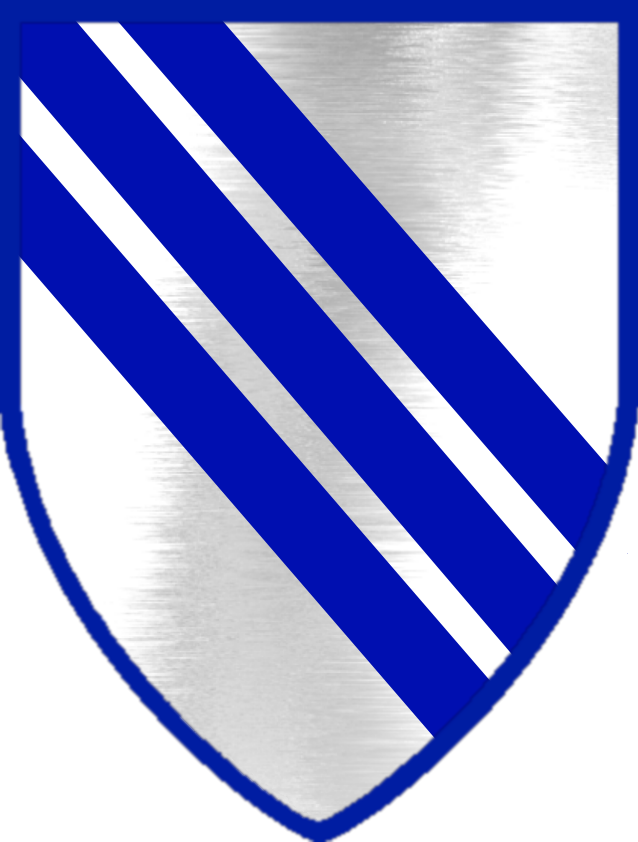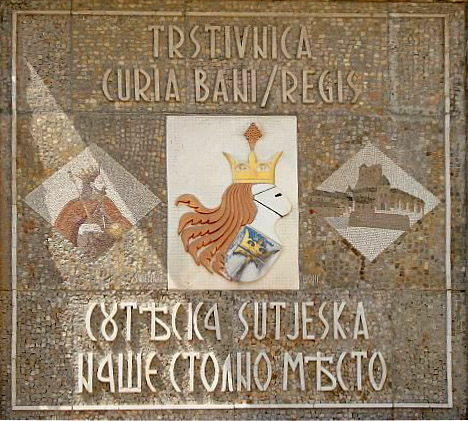|
Dragiša Dinjčić
Dragiša Dinjičić ( sr-Cyrl, Драгиша Дињичић) was a knez from the Bosnian noble Dinjičić family, which had its estates in the eastern parts of the medieval Bosnian state, in the Jadar region. He was the son of the Župan Dinjica. Dinjica is succeeded by Knez Dragiša Dinjčić, probably his son. Dragiša Dinjčić is known for his active participation in the conspiracy against Knez Pavle Radinović and his murder in walk through Parena Poljana valley, between royal court in Sutjeska and royal fortress-town Bobovac, on 22 August 1415. After this event, open hostility arose among the Bosnian nobility. As such a situation did not suit Sultan Mehmed I, he initiated a new session of ''stanak'' through his representatives. During the ''stanak'', the King Ostoja was blamed for this event, as well as Dinjčićs, whose arrest was ordered. Like King Ostoja, Dragiša escaped arrest, and as a man of King Tvrtko II Stephen Tvrtko II ( sh-Latn-Cyrl, Stjepan/Stefan Tvrtko, ... [...More Info...] [...Related Items...] OR: [Wikipedia] [Google] [Baidu] |
Gospodin
''Gospodar'' or ''hospodar'', also ''gospodin'' as a diminutive, is a term of Slavic languages, Slavic origin, meaning "lord" or "Master (form of address), master". The compound (, , , sh-Latn-Cyrl, gospodar, господар, ) is a derivative of ''gospod'' / ''gospodin'', , or when spelled with a capital G (''Gospod'' / ''Gospodin'') it translates as Lord for God. Etymology The etymology of the word can be traced back to the connotation of the Indo-European patron-client and guest-host relationship. Patron-client Rich patrons sponsored feasts as a way for them to promote and secure a political hierarchy built on the unequal mobilization of labor and resources, by displaying their generosity towards the rest of the community. Rivals competed publicly through the size and complexity of their feasts, and alliances were confirmed by gift-giving and promises made during those public gatherings. The host of the feast was called the *''ghosti-potis'', the 'lord of the guests', who ... [...More Info...] [...Related Items...] OR: [Wikipedia] [Google] [Baidu] |
Bobovac
Bobovac ( sh-Cyrl, Бобовац) a historic site, was a fortified royal capital city of medieval Bosnia and Herzegovina, and as such a seat of Bosnian rulers during 14th and 15th century. It is located near today's Vareš and the village of Borovica, and close to the Royal court in Sutjeska, in present-day village of Kraljeva Sutjeska. It is a protected national heritage site as a National monument of Bosnia and Herzegovina by KONS. History The city was built during the reign of Stephen II, Ban of Bosnia, and was first mentioned in a document dating from 1349. It shared the role of seat of the rulers of Bosnia with the court in Sutjeska, or as it called today, Kraljeva Sutjeska, however Bobovac was much better fortified than the other. Bosnian King Stephen Tomašević moved the royal seat to Jajce during his war with the Ottoman Empire. The Ottomans invaded the city in 1463. Its fall hastened the Ottoman conquest of Bosnia. Main structures and architectural style Within ... [...More Info...] [...Related Items...] OR: [Wikipedia] [Google] [Baidu] |
Medieval Bosnian Nobility
In the history of Europe, the Middle Ages or medieval period lasted approximately from the 5th to the late 15th centuries, similarly to the post-classical period of World history (field), global history. It began with the fall of the Western Roman Empire and transitioned into the Renaissance and the Age of Discovery. The Middle Ages is the middle period of the three traditional divisions of Western history: classical antiquity, the medieval period, and the modern period. The medieval period is itself subdivided into the Early Middle Ages, Early, High Middle Ages, High, and Late Middle Ages. Population decline, counterurbanisation, the collapse of centralised authority, invasions, and mass migrations of tribes, which had begun in late antiquity, continued into the Early Middle Ages. The large-scale movements of the Migration Period, including various Germanic peoples, formed new kingdoms in what remained of the Western Roman Empire. In the 7th century, North Africa and the ... [...More Info...] [...Related Items...] OR: [Wikipedia] [Google] [Baidu] |
Sandalj Hranić
Sandalj Hranić Kosača ( cyrl, Сандаљ Хранић Косача; 1370 – 15 March 1435) was a powerful Bosnian nobleman whose primary possessions consisted of Hum, land areas between Adriatic coast, the Neretva and the Drina rivers in Bosnia, and served the court as the ''Grand Duke of Bosnia'' sometime between 1392 and his death in 1435, although the first mention as a Grand Duke in sources comes from 16 June 1404. He was married three times, but had no children. After his death, he was succeeded by his nephew Stjepan Vukčić Kosača. His father was Hrana Vuković. Rise of Sandalj As the head of the House of Kosača, Sandalj Hranić succeeded his uncle Vlatko Vuković in 1392. In 1403, Radič Sanković led the attacks on Dubrovnik during the Bosnian-Ragusan War in the name of King Stephen Ostoja. Sandalj Hranić captured and blinded Radič, and held him in prison until his death in 1404. When King Ladislaus of Naples sold his rights to the kingdom of Da ... [...More Info...] [...Related Items...] OR: [Wikipedia] [Google] [Baidu] |
Tvrtko II Of Bosnia
Stephen Tvrtko II ( sh-Latn-Cyrl, Stjepan/Stefan Tvrtko, Стјепан/Стефан Твртко; died in November 1443), also known as Tvrtko Tvrtković (), was a member of the House of Kotromanić who reigned as King of Bosnia from 1404 to 1409 and again from 1420 to his death. Tvrtko II was the son of King Tvrtko I. His reigns took place during a very turbulent part of Bosnian history. He was first installed as a puppet king by the kingdom's leading noblemen, Hrvoje Vukčić Hrvatinić and Sandalj Hranić Kosača, to replace his increasingly dependent uncle Ostoja. Five years later, he lost the support of the nobility and thus the crown as well. He was hardly politically active during the second reign of Ostoja, but managed to depose and succeed Ostoja's son Stephen. Tvrtko's second reign was marked by repeated Turkish raids, which forced him to accept the Ottoman suzerainty, and the struggle for power with Radivoj, another son of Ostoja. Tvrtko was married twice, but died ... [...More Info...] [...Related Items...] OR: [Wikipedia] [Google] [Baidu] |
Ostoja Of Bosnia
Stephen OstojaHis name in Bosnian is rendered Stjepan Ostoja (), while in Croatian it is Stjepan Ostoja. In Serbian, he is called Stefan Ostoja (). ( sh-Latn-Cyrl, separator=" / ", Stjepan Ostoja, Стјепан Остоја; died September 1418) was King of Bosnia from 1398 to 1404 and from 1409 to 1418. Family connections He was a member of the House of Kotromanić, most likely son of Vladislaus and brother of King Tvrtko I. When duke Hrvoje Vukčić in 1416 died, King Ostoja divorced his old wife Kujava from the house of Radinović and married Hrvoje's widow Jelena Nelipčić the next year.John Van Antwerp Fine, Bosnian Institute; ''The Bosnian Church: Its Place in State and Society from the Thirteenth to the Fifteenth Century'', Saqi in association with The Bosnian Institute, 2007 Jelena Nelipčić was the sister of Prince Ivan III Nelipić from the Croatian noble Nelipić family. That way Ostoja inherited most of Hrvoje's lands. Rise to power Ostoja was brought to ... [...More Info...] [...Related Items...] OR: [Wikipedia] [Google] [Baidu] |
Stanak
''Stanak'' is the most common name used to refer to the assembly of nobility in medieval Bosnia. The assembly, in the original Bosančica: (), was also known as the ''Rusag'' (from the Hungarian word ''orszag'', meaning "state" or "nation"), ''Rusag bosanski'', ''Zbor'', ''Sva Bosna'' (meaning "Whole of Bosnia") or just ''Bosna'', with the officials of the Republic of Ragusa employing several Latin terms as well. The term ''"stanak sve zemlje Bosne",'' is first attested in the charter of Tvrtko I in 1354. Its influence peaked between the 1390s and the 1420s. The Serbian historian Sima Ćirković and most other Yugoslav scholars believed that the existence of the ''stanak'' proved a unity and feeling of belonging to a Bosnian identity and integrity, but also illustrated weakness of the monarch and decentralization of the state, as argued by American colleague John Van Antwerp Fine, Jr. The right to take part in the sessions of the s''tanak'' was enjoyed by every Bosnian '' kne ... [...More Info...] [...Related Items...] OR: [Wikipedia] [Google] [Baidu] |
Mehmed I
Mehmed I (; – 26 May 1421), also known as Mehmed Çelebi (, "the noble-born") or ''Kirişçi'' (, "lord's son"), was the sultan of the Ottoman Empire from 1413 to 1421. Son of Sultan Bayezid I and his concubine Devlet Hatun, he fought with his brothers over control of the Ottoman realm in the Ottoman Interregnum (1402–1413). Starting from the province of Rûm he managed to bring first Anatolia and then the European territories (Rumelia) under his control, reuniting the Ottoman state by 1413, and ruling it until his death in 1421. Called "The Restorer," he reestablished central authority in Anatolia, and he expanded the Ottoman presence in Europe by the conquest of Wallachia in 1415. Venice destroyed his fleet off Gallipoli in 1416 as the Ottomans lost a naval war. Early life Mehmed was born in 1386 or 1387 as the fourth son of Sultan Bayezid I () and one of his consorts, the slave girl Devlet Hatun. Following Ottoman custom, when he reached adolescence in 1399, he was sent ... [...More Info...] [...Related Items...] OR: [Wikipedia] [Google] [Baidu] |
Royal Court In Sutjeska
Royal Court in Sutjeska was a medieval Bosnian court, residence, and administrative seat of the Bosnian king, from mid-fourteenth to mid-fifteenth century, located in present-day Kraljeva Sutjeska, Bosnia and Herzegovina. The compound consisted of several buildings, chapel, and the nucleus of what would later become Kraljeva Sutjeska Franciscan Monastery. History The court in Trstionica (present-day Kraljeva Sutjeska) was established by Ban of Bosnia, Stjepan II Kotromanić. Location The court remains are located in present-day Kraljeva Sutjeska, Bosnia and Herzegovina. The remains of the royal court are situated on the small prominence next to the Kraljeva Sutjeska Franciscan friary and church. This prominence is called Grgurevo. The site is separated in two distinct parts by small Urva brook. The court and its chapel are mentioned in 1378 in the charter of the King Tvrtko I. The court chapel (church) was dedicated to Saint Gregory the Miracle-Worker (''Sveti Grgur Čudot ... [...More Info...] [...Related Items...] OR: [Wikipedia] [Google] [Baidu] |



